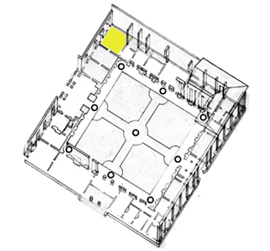horizontal view

audio video - Camera dei Giganti
Camera dei Giganti
I limiti architettonici dell'ambiente sono dissimulati da espedienti costruttivi e trasfigurati da una stesura pittorica ininterrotta, che circonda e coinvolge lo spettatore con stupefacente potere illusionistico. La scala gigante dei primi piani e le improvvise fughe prospettiche dei paesaggi o, in alto verso l'Olimpo, aumentano la suggestione. In origine tra le due finestre si trovava un camino, e il pavimento, di ciottoli di fiume, manteneva la continuità con le pareti, allora dipinte a finti ciottoli nella parte inferiore. Il tema iconografico, probabile allegoria di Carlo V che trionfa sui nemici e sugli eretici, è quello della punizione dei Giganti ribelli che tentano l'assalto all'Olimpo. Il Vasari dedica una pagina affascinante a questa camera, probabilmente la più celebre del palazzo. Le pareti, fino ad altezza d'uomo, sono ricoperte di iscrizioni per la maggior parte antiche (alcune risalgono al Cinquecento), preservate dal recente restauro per il loro valore di documento storico.
Room of the Giants
The architectural boundaries of this room are concealed
by uninterrupted paintings that surround and overwhelm the spectator with
their breathtaking illusions. The huge scale of the foreground figures
and the unexpected flight of the eye into the deep space of the landscapes
or into the perspective illusion of the throne of Jupiter on Olympus increase
the effect. The story, that of the ancient Greek gods punishing the rebel
giants who had attemtped an assault on Olympus, is probably an allegory
of the Emperor Charles V triumphing over his enemies and over heretics.
(Note that the eagle was a symbol both of Jupiter, king of the gods, and
of Charles V.) Originally there was a fireplace between the two windows,
and the floor was made of river pebbles that seemed to continue the pebbles
that were then painted at the bottom of the walls. At eye level, the walls
are covered with graffiti, most of which is very old, even from the sixteenth
century. During a recent restoration of the room a decision
was made to retain the graffiti for their historic value.